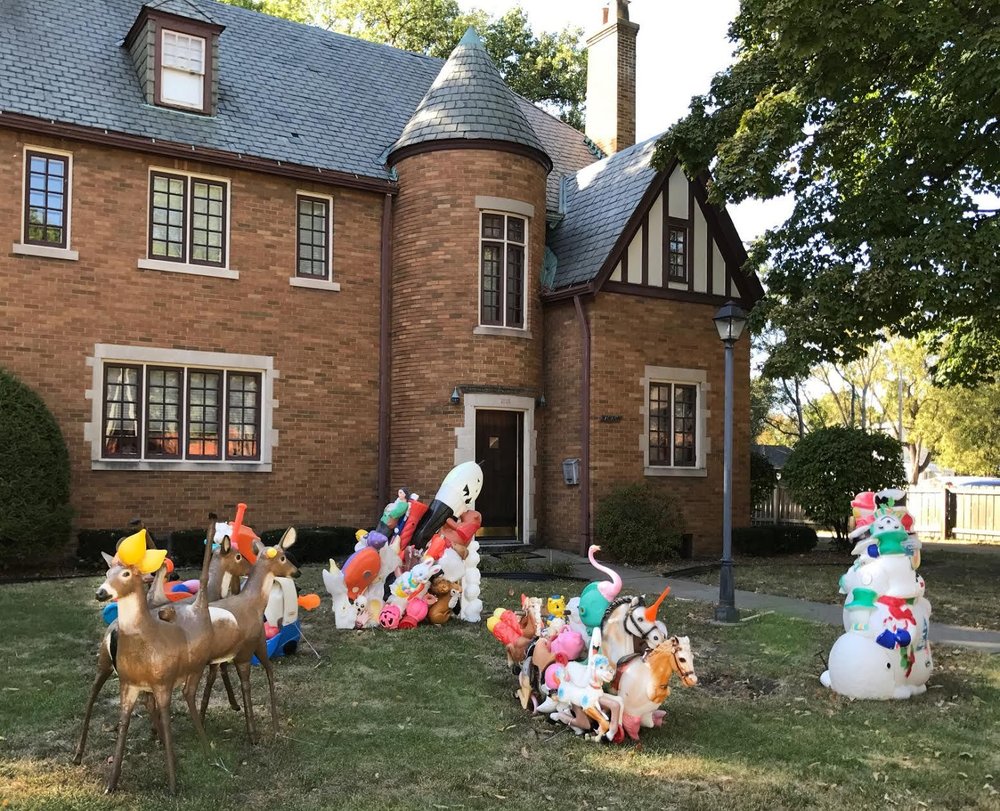
Terrain Exhibitions is pleased to announce the development of a new residency and exhibition program, forged with the support of the Enos Park Residency for Visual Artists in Springfield, Illinois.
In 2017, the Enos Park neighborhood served as host to seventeen sites for the Third Terrain Biennial. Artists selected a variety of available sites – empty lots, deserted structures, grand historic homes and commercial businesses – where site-specific, temporary public artworks were developed and exhibited for six weeks. The effort revealed a special potency in bringing contemporary artists to Enos Park, and a unique spectrum of sites for artists to respond to.
To apply for the Terrain Artist Residency at Enos Park:
Please compile the following materials into a Google Drive folder. Be sure that the shareable link is set for public viewing to allow for the review process.
A statement that details your interest in the program and explains why the residency aligns well with you practice/research interests
-Current CV
-10 to 20 work samples
-Image script
-A list of three references
-Email your shareable link to: info@terrainexhibitions.org
Deadline for applications 11.59pm 04/01/2019
Terrain Exhibitions is offering two residency opportunities in 2019, each lasting six to eight weeks (as directed by the artist) and culminating with a public reception or presentation of work. The 2019 residency periods will fall in June/July and August/September. The fall residency dates for intersect with the 2019 Terrain Biennial.
Selected artists will reside in the Enos Park residency duplex as they develop site-responsive public works at sites in cooperation with homeowners, businesses, and the Enos Park Neighborhood Association. Terrain Exhibitions and the Enos Park Residency administrators will support artists to explore the neighborhood, scout potential sites, and establish relationships. There will be no shortage of sites for artists to consider.
The $50/week residency fee required by the Enos Park Residency program will be paid for by Terrain. At this time, we cannot offer an additional stipend for materials or travel.
About the Enos Park Residency for Visual Artists
The Enos Park Residency for Visual Artists is administered by the Springfield Art Association, and has previously collaborated on programs with the University of Illinois Springfield Visual Arts Gallery, DEMO Project, and Terrain Exhibitions, among others. Previous residents include Astrid Kaemmerling, James Pepper Kelley, Jessica Bingham, Allyson Packer, Nicholas Wylie, and Thaddeus Kellstadt.
While the residency aims to attracts artists interested in social practice, site-responsive research and community involvement, all for the sake of engaging the Enos Park neighborhood directly, the also program welcomes contemporary artists of all kinds.
Resident Artists reside in the spacious residency duplex. Each two-bedroom unit offers a private bedroom and a shared kitchen and bathroom. Downtown Springfield is a short walk away, and a 24-hour grocery store in within two blocks. The duplex sits on the campus of the Springfield Art Association (SAA), and resident artists have access to the SAA studios, among them: painting and drawing studio, metals lab, ceramics studio, a digital media studio, and a newly minted glass-blowing studio. There is no dedicated, private studio space on the SAA campus for resident artists at this time, but the program has been able to place resident artists in studio spaces that can accommodate the practice of each artist.
About Enos Park
Enos Park is a historic neighborhood in Springfield that has a long and complex history. The neighborhood is the oldest in the city and was once considered to be the “Jewel of Springfield.” It reached its peak during the late 1910’s and 1920’s, but during the 1930’s through the 1950’s, the neighborhood began a slow but steady physical decline. By the late 1970’s and 1980’s, some areas within the Enos Park neighborhood had become fairly blighted with many structures being condemned and demolished. In recent years, several groups and individuals have taken a strong interest in the neighborhood, rehabilitating many of the structures and attempting to revitalize neighborhood. A number of properties with architectural significance have been restored, and the historic character of the area prevails. A detailed overview of the neighborhood history can be found here:
http://www.epnia.com/history-and-development-of-the-enos-park-area/">http://www.epnia.com/history-and-development-of-the-enos-park-area/